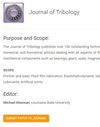激光模式和功率对直接能量沉积IN718合金摩擦学性能的影响
IF 3
3区 工程技术
Q2 ENGINEERING, MECHANICAL
引用次数: 0
摘要
研究了激光模式和功率对采用直接能量沉积(DED)技术添加铬镍铁合金718合金摩擦学性能的影响。样品采用连续波(CW)和脉冲波(PW)激光模式,使用700、900和1100W激光功率制造。对于CW和PW制造的样品,样品表现出高硬度(3-5 GPa)和模量(150–200 GPa),随着激光功率的增加而增加,这与第二相的致密化和硬化有关。对于CW样品,摩擦系数随着激光功率的增加而增加,但对于PW样品则减小。样品的磨损率提高了25到70×10−5 mm3/Nm。与任何激光功率下的连续波相比,脉冲波样品表现出更好的摩擦学行为。主要的磨损机制是三体磨料磨损,其次是局部和离散粘着磨损机制。本文章由计算机程序翻译,如有差异,请以英文原文为准。
Effect of Laser Mode and Power on the Tribological Behavior of Additively Manufactured IN718 Alloy Fabricated by Direct Energy Deposition (DED)
The influence of laser modes and power on the tribological behavior of additively manufactured Inconel 718 alloys using the direct energy deposition (DED) technique was investigated. The samples were fabricated with continuous wave (CW) and pulse wave (PW) laser modes using 700, 900, and 1100 W laser power. The samples exhibited high hardness (3-5 GPa) and modulus (150 – 200 GPa) which increases with the laser power for CW and PW fabricated samples, and this was associated with the increasing densification and hardening secondary phase. The coefficient of friction increases with laser power for the CW samples but decreases for the PW samples. The samples showed an improved wear rate ranging between 25 and 70 × 10−5 mm3/Nm. Pulse wave samples demonstrated better tribological behavior compared to continuous wave at any laser power. The dominant wear mechanism is the three-body abrasive wear followed by localized and discrete adhesion wear mechanism.
求助全文
通过发布文献求助,成功后即可免费获取论文全文。
去求助
来源期刊
CiteScore
4.20
自引率
12.00%
发文量
117
审稿时长
4.1 months
期刊介绍:
The Journal of Tribology publishes over 100 outstanding technical articles of permanent interest to the tribology community annually and attracts articles by tribologists from around the world. The journal features a mix of experimental, numerical, and theoretical articles dealing with all aspects of the field. In addition to being of interest to engineers and other scientists doing research in the field, the Journal is also of great importance to engineers who design or use mechanical components such as bearings, gears, seals, magnetic recording heads and disks, or prosthetic joints, or who are involved with manufacturing processes.
Scope: Friction and wear; Fluid film lubrication; Elastohydrodynamic lubrication; Surface properties and characterization; Contact mechanics; Magnetic recordings; Tribological systems; Seals; Bearing design and technology; Gears; Metalworking; Lubricants; Artificial joints

 求助内容:
求助内容: 应助结果提醒方式:
应助结果提醒方式:


